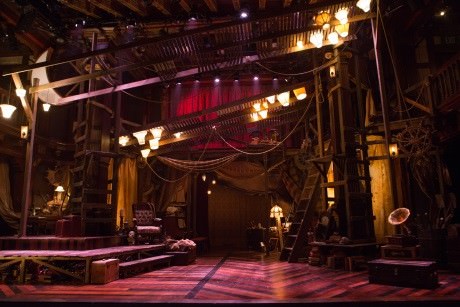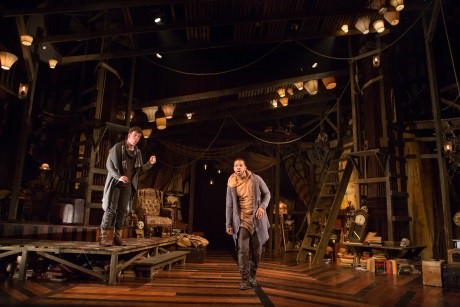Walking into the Folger Theatre, I did a double-take. This clearly was going to be a different visual experience for Tom Stoppard’s Rosencrantz and Guildenstern Are Dead as directed by Aaron Posner. The set was a handsome, two-level, quirky jumble. It was comfortably eccentric at first glance; like seeing something anew and fresh after a long time away.

The set for Rosencrantz and Guildenstern Are Dead was far from “a place without any visible character,” as Stoppard penned almost 50 years ago. Intriguing was an understatement. I was an audience member not sure where I was, where I was headed or what was to become of me. Quite like the boys of RosGuil, I was unfixed from my expectations.
Was there sacrilege going on at the Folger? Was innovation with this iconic Stoppard play no different from what some now come to expect with Shakespeare? Would an audience be enthralled as they were when Rosencrantz and Guildenstern won four Tony Awards including one for Best Play in 1968? Would Millennials care and come? Could there be more than just words to the sometimes head-scratching enjoyment of Rosencrantz and Guildenstern Are Dead and its ways of enlightenment.
Guildenstern says:
“Words, words.They’re all we have to go on.”
“What a fine persecution—to be kept intrigued without ever quite being enlightened.”
Dramaturg Michele Osherow’s informed, lively read in the Folger program provided another taste of arousal: “Director Aaron Posner sets this production in a theatrical attic-an alternative play space that rouses curiosity and fixes treasure to memory” with detritus from Hamlets past. Osherow described the set as “fantastically offbeat.” Yup, right she is, and delightfully so.
One other note, Rosencrantz and Guildenstern Are Dead is a marvelously sharp, vibrant, firing-on-all-cylinders production about two sympathetic pawns on the way to exiting this world. The production has already been extended. But, this is not a review, rather a feature about the scenic design.So off I went for a chat with Director Aaron Posner.

Tell our readers a bit about Scenic/Properties Designer Paige Hathaway.
Aaron: Paige was a student of mine at the University of Maryland and she is quite simply one of the best young set designers I have encountered. She is smart, insightful, creative and with an extraordinary aesthetic sensibility. I think she will do great things and I was just excited to be able to offer her this opportunity.
Did you have a set design in mind for Rosencrantz and Guildenstern Are Dead?
The idea for the “Hamlet Attic” was Paige’s. It came out of our initial conversations about the structure of the play, and the energy of the play, and where I hoped to take it in this production, but it was really her innovation. I think it does exciting things for the play and helps the audience see it with new eyes. It also provides a really fun and dynamic playground for the performers.
What do you look at when working with your Set Designer?
As a director I am always looking for all the design elements to serve the story we are trying to tell. That is the first and last question: Will this help tell the story we are interested in telling? And then there are lots of ancillary questions about beauty and utility and practicality and variety and such. But I think Paige’s set accomplishes everything I could hope for. She is the real deal.
And that’s when I met up with Scenic and Properties Designer Paige Hathaway, so that I could learn more.
What are some of the things you enjoy most about being a scenic designer?
Paige: One of my favorite things about scenic design is that each production offers me an opportunity to learn something new. I get to explore different regions, eras, traditions, movements, and art forms – things that I wouldn’t have thought to immerse myself in otherwise. It’s an enormous gift! I also enjoy the people in the theater. There’s something incredibly special about coming together and collaborating to create a living, breathing piece of art.
What influenced you in your artistic choices for the scenic and properties design for Rosencrantz and Guildenstern Are Dead?
My choices for the design began with a kernel of an idea from our director, Aaron Posner. He told me that the core of the play was a story of two young people who find themselves completely and utterly out of their depth, lost in a world where they don’t know the rules. It’s like being at a fancy dinner party and experiencing the anxiety of not knowing which fork to use.
Being a 26 year-old at the very beginning of my theatrical design career, I can completely identify with the feeling. This primal awareness of being lost led to my development of the “attic” idea – a place that can feel nostalgic, warm, full of possibilities or frightening, secretive, and ominous. The play lives in both of these worlds and it felt natural to place our main characters there, two kids lost in an attic.
How do you describe the set for Rosencrantz and Guildenstern Are Dead, including its off-kilter elements?
I would describe the set as a whimsical Hamlet-attic with a looming presence of death. Hopefully that’s what the audience gets from it too! There were additions up until the last couple of days of previews, but most of it was just to fully flesh out the dressing. For example, at the beginning of preview performances we got a final large batch of human skulls (cast and molded by the Prop Master, Lauren Chilton) that I was able to hide around the set. It has become quite a competition to see if you can spot all the skulls! I also added a shockingly realistic severed head from Folger’s storage that is my favorite Easter egg for an observant audience member. It has been an incredible pleasure to put in all of the odd, eccentric touches to the set.
Were the upside down incandescent lamp shades in your scenic design from the very beginning?
Oddly enough, they were there from the very beginning. The idea came from some research I had done into theatrical spaces, specifically prop warehouses and storage spaces. There was a particular image that stuck with me of this narrow aisle in a prop storage space with about a hundred empty lamp shades strung up overhead. I’m a huge fan of using practical lighting fixtures onstage, so I thought that it would add a lovely eccentric touch to our Hamlet-attic.

What were some of the biggest challenges in designing the set, building the set, and loading it into the Folger space?
Obviously, the Folger space presents some amazing challenges; there are two permanent columns, some difficult sightlines, minimal structure from which to hang things, and almost no backstage space – but it is also insanely beautiful and rich.
For this particular play, I feel blessed that the Elizabethan structure of the Folger was there to create more depth and texture to the design. As for building and loading in the set- thankfully I personally didn’t have to deal with the logistics too much. There’s an extraordinary team at the Folger (Charles Flye and Rebekah Sheffer) who managed everything flawlessly. They didn’t shirk away from the challenge of the massive ceiling pieces, two dozen practical lighting fixtures, obscene amount of furniture and props, or the limited time for them to execute all of this. And given that the cast rehearsed on the actual set from the beginning of the rehearsal process, which is as rare as it is wonderful.
How do you design? Do you use Photoshop or pencil/ink drawings and/or models?
My design process depends largely on the set that I’m trying communicate. I primarily use Photoshop to render my set designs as I think it can convey pretty accurately what the set could look like in real life. By using actual photos of people, furniture, and textures in a rendering, I feel that the director and creative team can more fully understand what the possibilities and realities are of the design.
Alternately, some sets just lend themselves better to being drawn or painted. Fabric, for example, is infinitely easier to draw than it is to find the perfect image online to then drop into Photoshop and adjust. I use both of these rendering techniques as a precursor to building a scale model. Nothing can quite replace having a 3-dimensional object in front of you that you can visually explore. Additionally, on my end, models are a great way to work through any spacial flaws in my design- which was especially necessary for a space as complex as the Folger.
Running Time: 2 hours and 40 minutes, including one intermission.
Rosencrantz and Guildenstern are Dead plays at Folger Theatre at the Folger Shakespeare Library—201 East Capitol Street, SE, in Washington, DC, through June 28, 2015. For tickets, call the box office at (202) 544-7077, or purchase them online.
LINKS
‘Rosencrantz and Guildenstern are Dead’ reviewed on DCMTA by Sophia Howes.
‘Rosencrantz and Guildenstern are Dead’ by Robert Michael Oliver in his column ‘Spine.’
https://youtu.be/AxyNXciuby4





